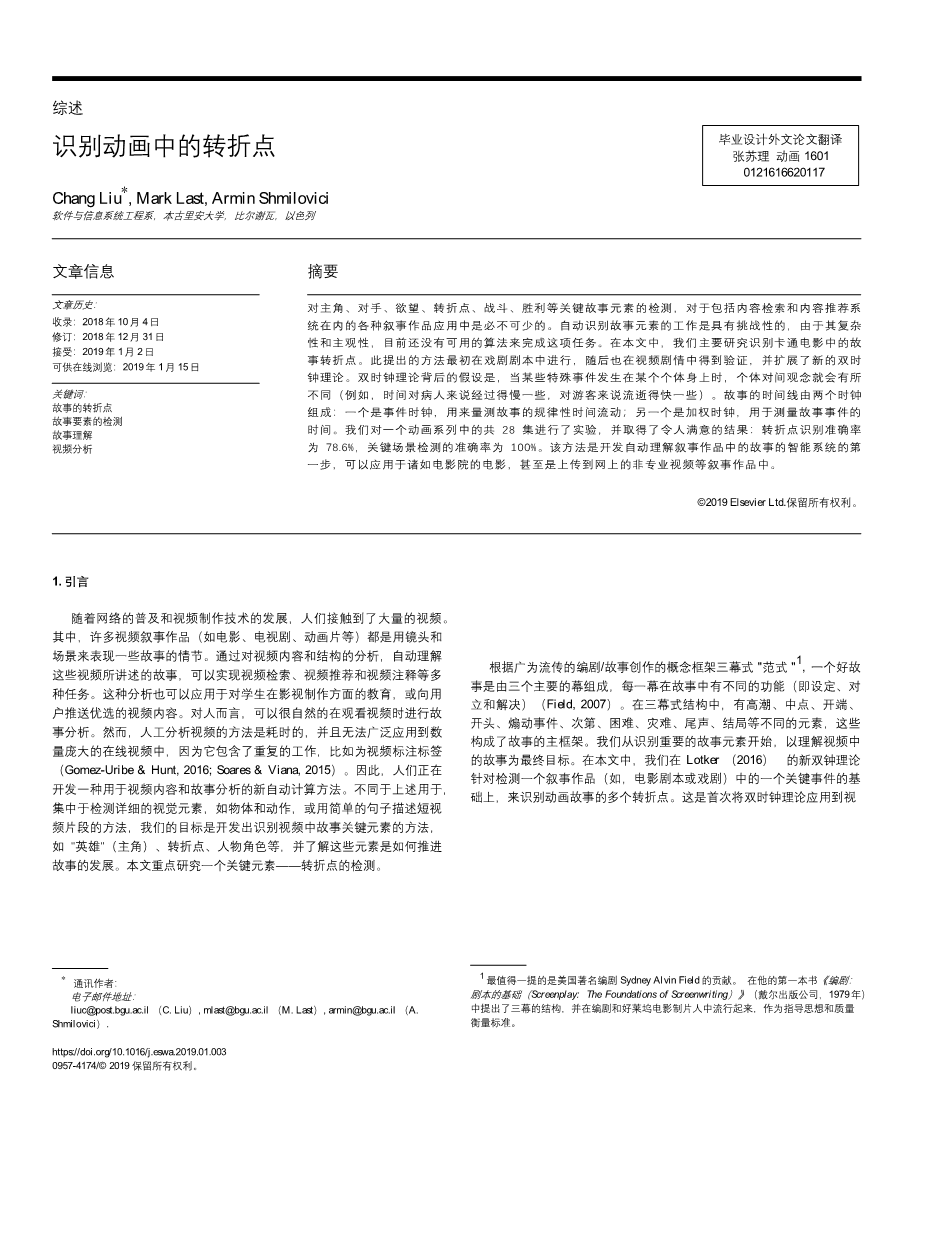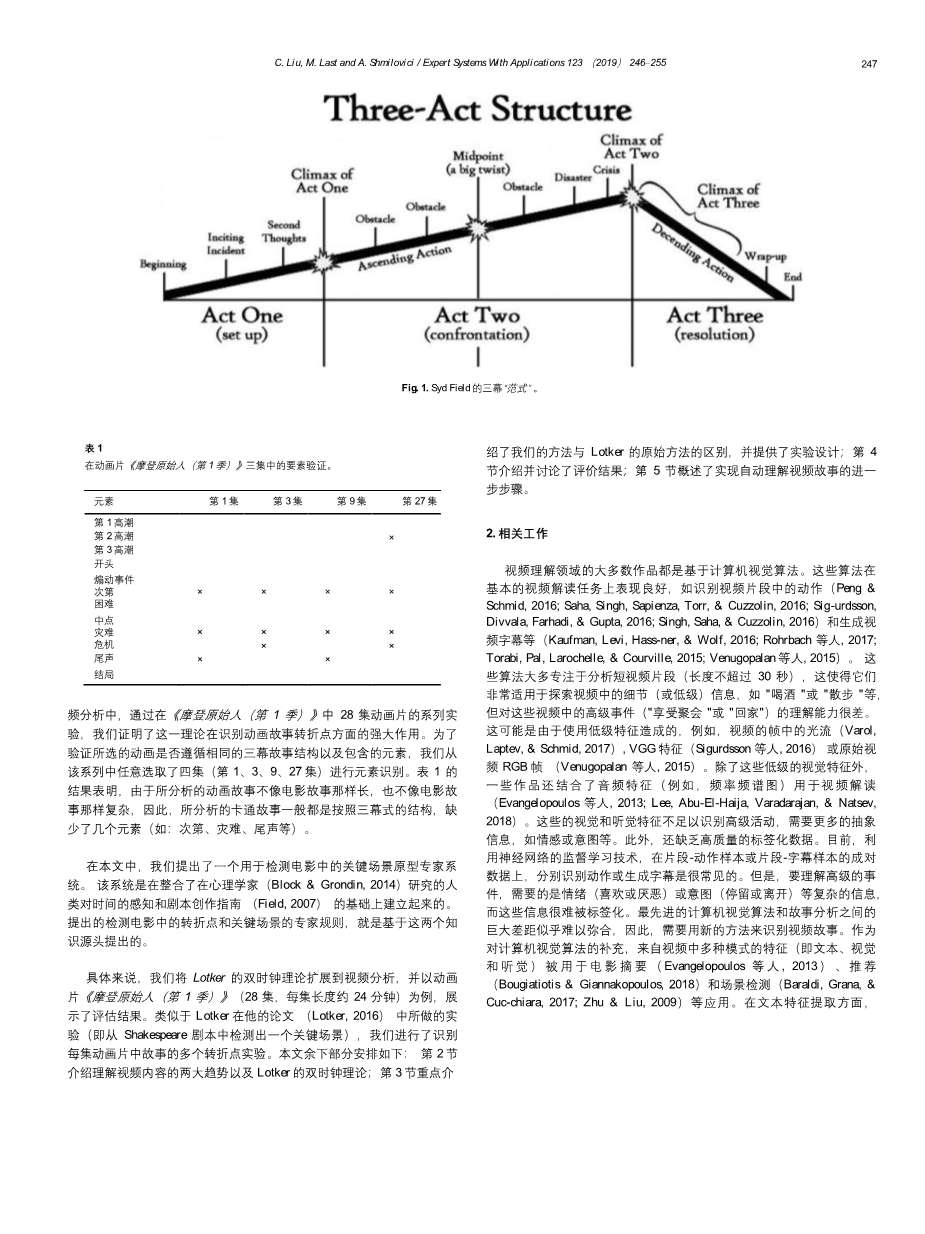Expert Systems With Application s 123 (2019) 246-255
Contents lists availa ble at ScienceDirect
Expert Systems With Applications
ELSEVIER
journal homepage: www.elsevier.com/locate/eswa
Review
Identifying turning points in animated cartoons
豆]
Chang Liu*, Mark Last, Armin Shmilovici
Department of Software and Information Systems Engineering, Ben-Gu rion University, Beer Shenu;口,Israel
A R T I C L E I N F O A B S T R A C T
Articl e history:
Received 4 October 2018
Revised 31 December 2018
Accepted 2 January 2019
Available online 15 January 2019
Keywords.
Storyrsquo;s turning points Story elements detection Story understand ing
Video analytics
Detecting key story elements such as protagonist, opponent, desire, turning points, battle, and victory, etc. is essential for various narrative work applications including content retrieval and content recommendashy; tion systems. The task of automatically identifying story elements is challenging because of its complexity and su均ectiveness and currently, there are no available algorithms for this task. In this paper, we focus on identifying turning points in a story of a cartoon movie. The proposed methodology extends the novel two-clocks theory, originally validated on scripts of theatre plays, to video stories. The assumption behind the two-clocks theory is that the perception of time is different when some special event happens to a certain agent ( e.g., time flows slower for a patient and quicker for a tourist ). The story timeline is monishy; tored with two clocks: an event clock, which measures the regular time flow of the story; and a weighted clock, which measures the timing of the story events. We have conducted an experiment on 28 episodes of a cartoon series and achieved promising results: 78.6克 precision for turning points identification and 100% precision for key scene detection. The proposed approach is the first step towards development of intelligent systems for automated understanding of stories in narrative works such as cinema movies and
even amateur videos uploaded to the Internet.
。2019 Elsevier Ltd. All rights reserved .
- Introduction
With the widely spread of web accessibility and the develshy; opment of video producing technologies, people are exposed to a massive amount of videos. A口10ng them,pi;1any video narrative works (e.g., movies, TV series, cartoons, etc.) are made with shots and scenes presenting the plot of some story. Automated undershy; standing of the stories told by such videos via analyzing the video content and structure can be beneficial for multiple tasks includshy;
ing video retrieval, video recommendation, and video annotation. This kind of analysis can also be utilized for educating students in film production or delivering preferable video content to users. It is natural for a human to perform video story analytics by watchshy; ing the videos. However, the manual approach is time-consuming and not scalable to massive amounts of online videos as it contains repetitive efforts such as assigning annotation tags to the videos ( Gomez-Uribe amp; Hunt, 2016; Soares amp; Viana, 2015 ). Therefore aushy; tomatic copi;1putational 口1ethods are being developed for video conshy; tent and story analytics. Unlike many of these methods, which conshy; centrate on detecting detailed visual elements such as objects and
- Corresponding author.
E-mail 日ddresses: liuc@post.bgu.ac.il (C. Liu ). mlast@bgu.ac.il (M. Last ), armin@bgu.ac.il (A. Shmilovici)
https://doi.org/ 10.1016/j.eswa.2019 .01.003
0957-4174/copy; 2019 Elsevier Ltd . All rights reserved.
actions or describing short video clips with simple sentences, we
aim at developing methods to identify the key elements of a story in a video, such as the “hero” ( the protagonist ), the turning points,
the roles of the characters. etc, and to understand how the eleshy; ments advance the story. This paper focuses on detection of one key ele口1ent - the turning points.
According to the widely used three-act “Paradigm 叶 ,a concepshy; tual scheme of scriptwriting/story-writing, a good story is comshy; posed of three main acts and each of them plays a different role in the story ( i.e., the set up, confrontation, and resolution ) (Field, 2007 ), as shown in Fig. 1. There are different elements within the three-act structure, such as climaxes, midpoint, beginshy; ning, inciting incident, second thoughts, obstacles, disaster, wrapshy; up and E时,which construct the main framework of a story. With the ultimate goal of understanding stories in videos, we start by identifying important story elements. ln this paper, we build upon an innovative two-clocks theory from Lotker (2016 ) that is aimed at detecting one key event in a narrative work (e.g., a movie script or a theater play) to identify multiple turning points of cartoon stories. This is the first application of the two-clocks theory to
1 The most notable contribution of the lead ing American screenwriter. Sydney Alvin Field . The structure of three-act was proposed in his 日rst book Screenplay: The Foundation s of Screenwriting (Dell Publishing, 1979), and became popular among writers and Hollywood film producers as guideline and quality measurement .
C. Liu, M. Last and A. Shmilovici / Expert Systems With Applications 123 (2019) 246-255 247
Three-Act Structure
Act One
(set up)
Act Two
(c01l岳阳tation)
Act Tl:ttee
(resolution)
剩余内容已隐藏,支付完成后下载完整资料


英语译文共 4 页,剩余内容已隐藏,支付完成后下载完整资料
资料编号:[235366],资料为PDF文档或Word文档,PDF文档可免费转换为Word


